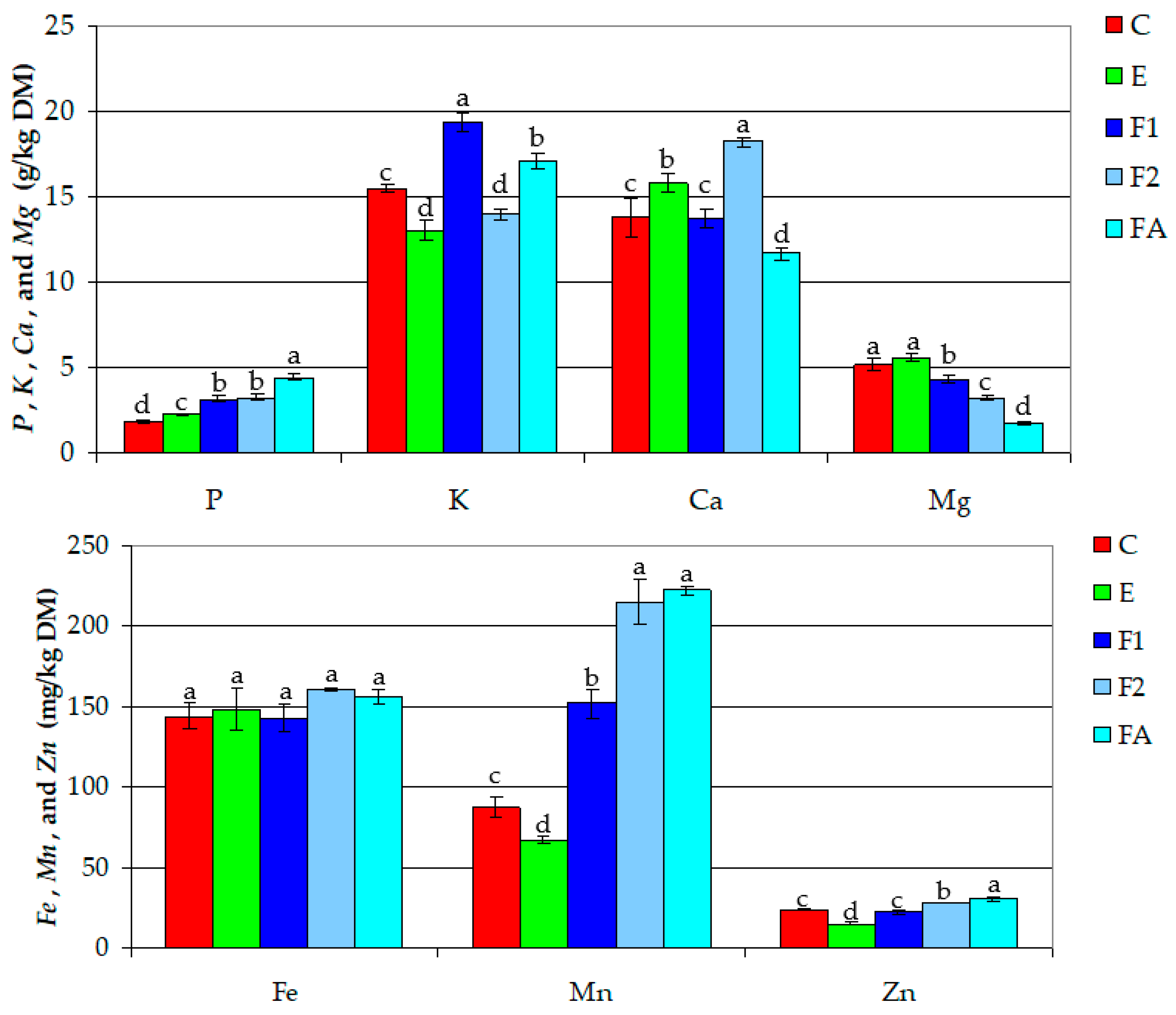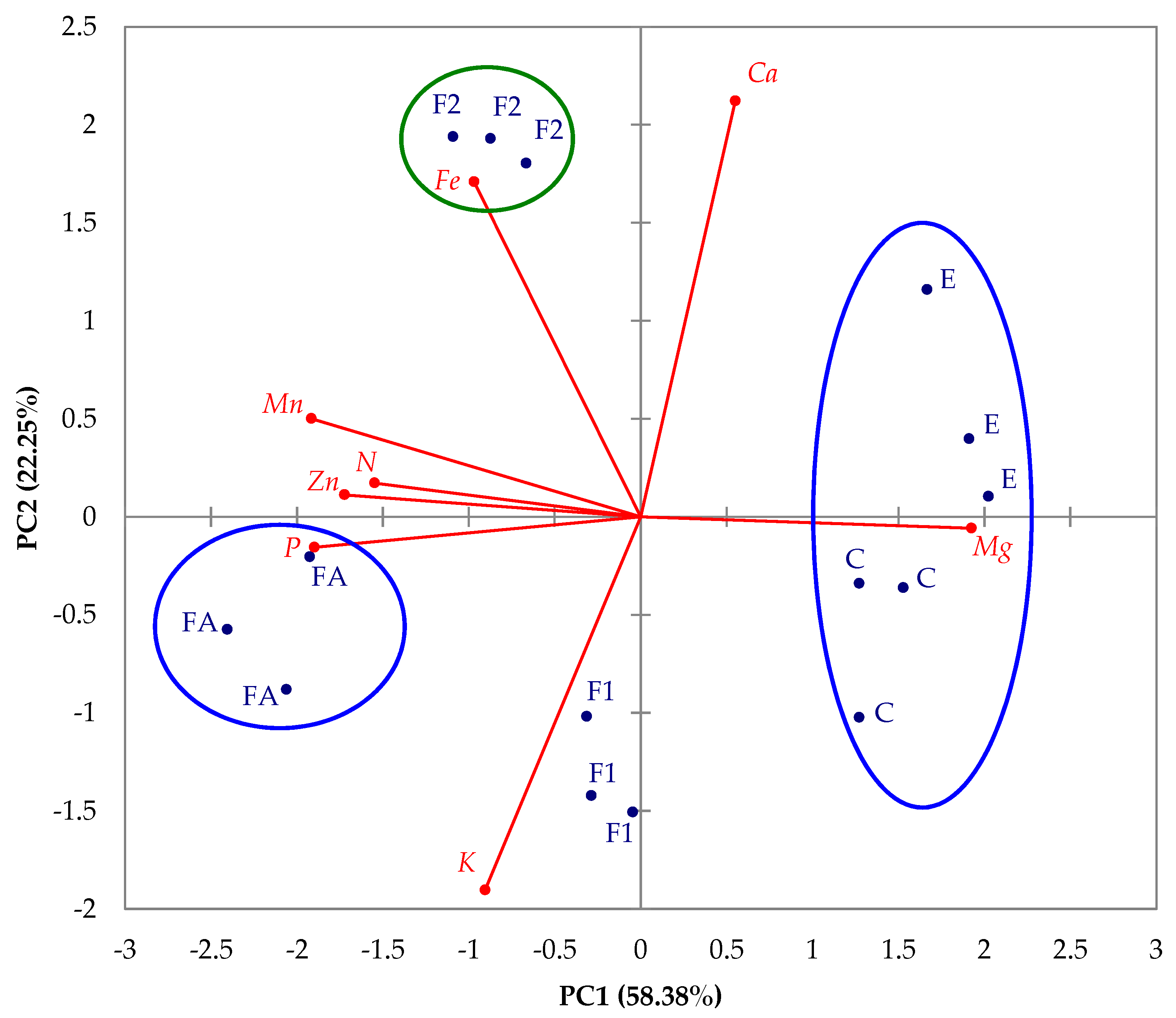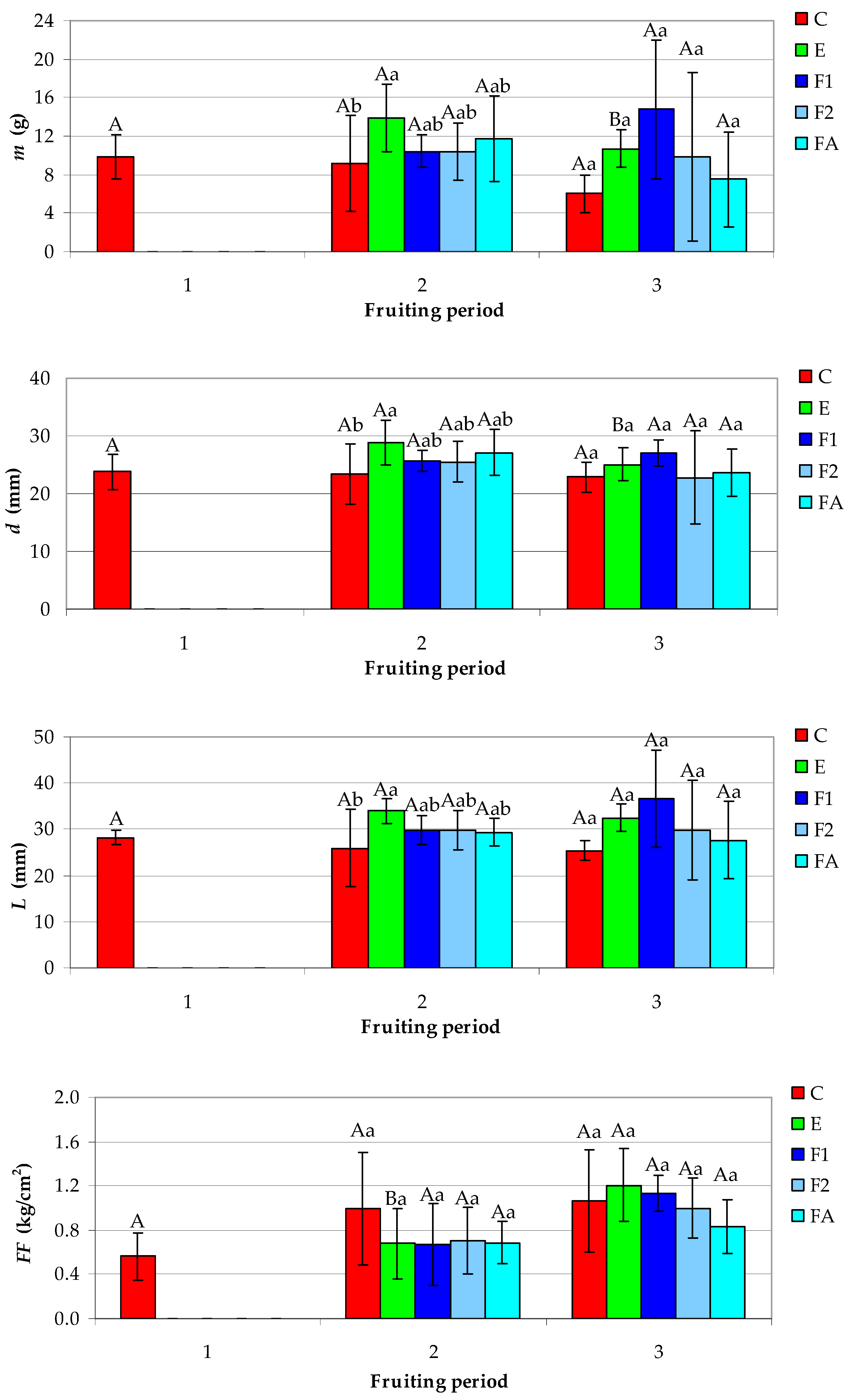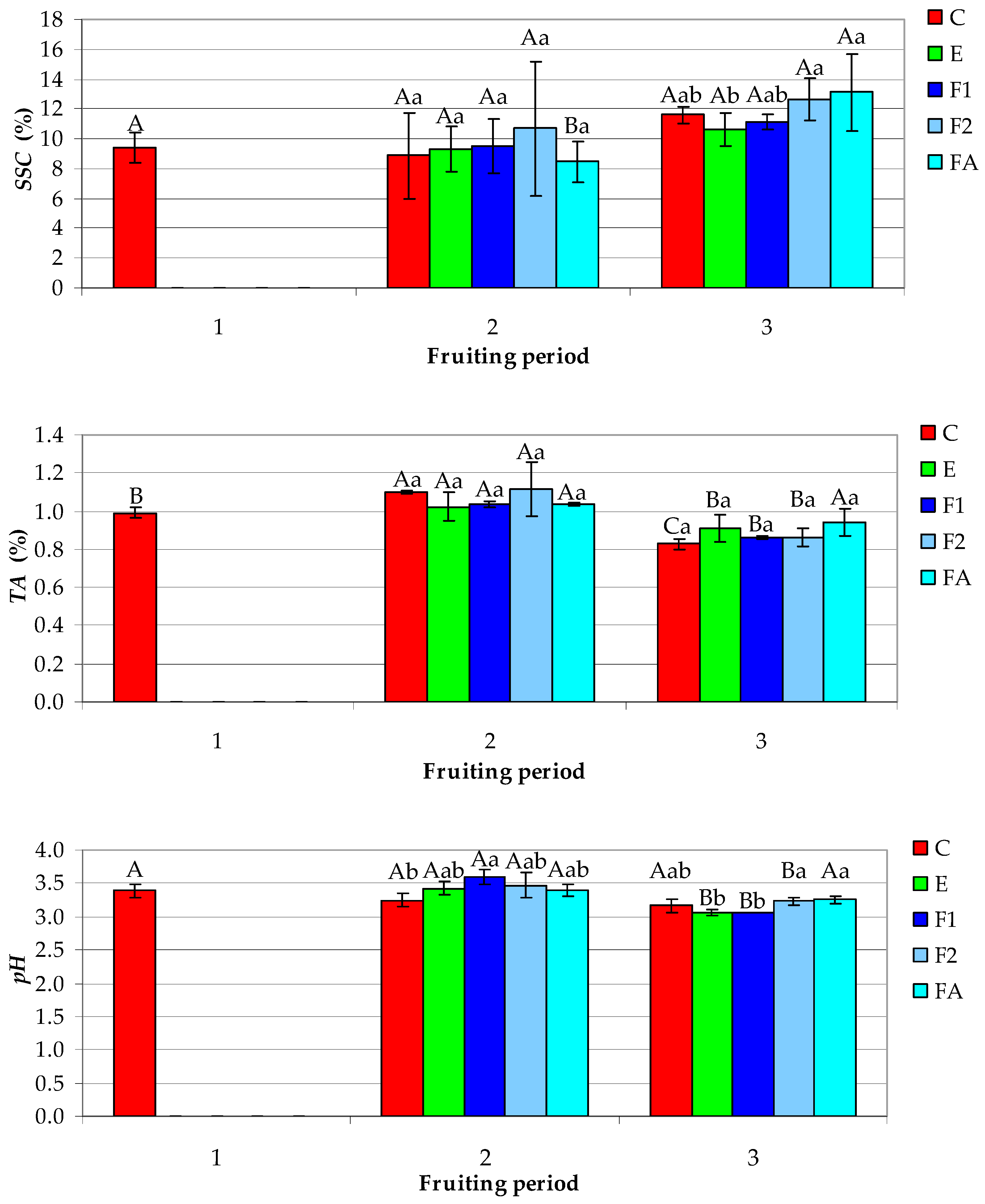Effects of Marine Residue-Derived Fertilizers on Strawberry Growth, Nutrient Content, Fruit Yield and Quality
Abstract
1. Introduction
2. Materials and Methods
2.1. Plant Material
2.2. Fertilizers
2.3. Strawberry Growth Experiment
2.4. Plant Analysis
2.5. Statistical Analysis
3. Results and Discussion
3.1. Nutrient Concentrations in Organic Fertilizers and Nutrient Inputs per Plant
3.2. Characteristic Parameters of Strawberry Leaves
3.3. Fruit Yield and Physicochemical Characteristics
4. Conclusions
Supplementary Materials
Author Contributions
Funding
Institutional Review Board Statement
Informed Consent Statement
Data Availability Statement
Conflicts of Interest
References
- Kilic, N.; Burgut, A.; Gündesli, M.A.; Nogay, G.; Ercisli, S.; Kafkas, N.E.; Ekiert, H.; Elansary, H.O.; Szopa, A. The effect of organic, inorganic fertilizers and their combinations on fruit quality parameters in strawberry. Horticulturae 2021, 7, 354. [Google Scholar] [CrossRef]
- de Jesús Ornelas-Paz, J.; Yahia, E.M.; Ramírez-Bustamante, N.; Pérez-Martínez, J.D.; del Pilar Escalante-Minakata, M.; Ibarra-Junquera, V.; Acosta-Muñiz, C.; Guerrero-Prieto, V.; Ochoa-Reyes, E. Physical attributes and chemical composition of organic strawberry fruit (Fragaria x ananassa Duch, Cv. Albion) at six stages of ripening. Food Chem. 2013, 138, 372–381. [Google Scholar] [CrossRef] [PubMed]
- Giampieri, F.; Tulipani, S.; Alvarez-Suarez, J.M.; Quiles, J.L.; Mezzetti, B.; Battino, M. The strawberry: Composition, nutritional quality, and impact on human health. Nutrition 2012, 28, 9–19. [Google Scholar] [CrossRef] [PubMed]
- Gunness, P.; Kravchuk, O.; Nottingham, S.M.; D’Arcy, B.R.; Gidley, M.J. Sensory analysis of individual strawberry fruit and comparison with instrumental analysis. Postharvest Biol. Technol. 2009, 52, 164–172. [Google Scholar] [CrossRef]
- Perkins-Veazie, P. Growth and ripening of strawberry fruit. Hort. Rev. 1995, 17, 267–297. [Google Scholar]
- Pinheiro, D.F.; Resende, J.T.V.D.; Constantino, L.V.; Hata, F.T.; Hata, N.N.Y.; Lustosa, S.B.C. Physical, biochemical, and sensory properties of strawberries grown in high-altitude tropical climate. Ciênc. E Agrotecnologia 2021, 45, 1–17. [Google Scholar] [CrossRef]
- Roussos, P.A.; Triantafillidis, A.; Kepolas, E.; Peppas, P.; Piou, A.; Zoti, M.; Gasparatos, D. Effects of integrated and organic management on strawberry (cv. Camarosa) plant growth, nutrition, fruit yield, quality, nutraceutical characteristics, and soil fertility status. Horticulturae 2022, 8, 184. [Google Scholar] [CrossRef]
- Urün, I.; Attar, S.H.; Sönmez, D.A.; Gündeșli, M.A.; Ercișli, S.; Kafkas, N.E.; Bandić, L.M.; Duralija, B. Comparison of polyphenol, sugar, organic acid, volatile compounds, and antioxidant capacity of commercially grown strawberry cultivars in Turkey. Plants 2021, 10, 1654. [Google Scholar] [CrossRef]
- D’Urso, G.; d’Aquino, L.; Pizza, C.; Montoro, P. Integrated mass spectrometric and multivariate data analysis approaches for the discrimination of organic and conventional strawberry (Fragaria x ananassa Duch.) crops. Food Res. Int. 2015, 77, 264–272. [Google Scholar] [CrossRef]
- Domingues, A.R.; Vidal, T.C.M.; Hata, F.T.; Ventura, M.U.; Gonçalves, L.S.A.; Silva, J.B. Postharvest quality, antioxidant activity and acceptability of strawberries grown in conventional and organic systems. Braz. J. Food Technol. 2018, 21, e2017154. [Google Scholar] [CrossRef]
- Fernandes, V.C.; Domingues, V.F.; de Freitas, V.; Delerue-Matos, C.; Mateus, N. Strawberries from integrated pest management and organic farming: Phenolic composition and antioxidant properties. Food Chem. 2012, 134, 1926–1931. [Google Scholar] [CrossRef]
- FAO. 2021. Available online: https://www.fao.org/faostat/en/#data/QCL (accessed on 21 February 2023).
- Antunes, M.C.; Cuquel, F.L.; Zawadneak, M.A.; Mogor, Á.F.; Resende, J.T. Postharvest quality of strawberry produced during two consecutive seasons. Hortic. Bras. 2014, 32, 168–173. [Google Scholar] [CrossRef]
- Cervantes, L.; Ariza, M.T.; Miranda, L.; Lozano, D.; Medina, J.J.; Soria, C.; Martínez-Ferri, E. Stability of fruit quality traits of different strawberry varieties under variable environmental conditions. Agronomy 2020, 10, 1242. [Google Scholar] [CrossRef]
- Gündüz, K.; Özbay, H. The effects of genotype and altitude of the growing location on physical, chemical, and phytochemical properties of strawberry. Turk. J. Agric. For. 2018, 42, 145–153. [Google Scholar] [CrossRef]
- Sayğı, H. Effects of organic fertilizer application on strawberry (Fragaria vesca L.) cultivation. Agronomy 2022, 12, 1233. [Google Scholar] [CrossRef]
- Cayuela, J.A.; Vidueira, J.M.; Albi, M.A.; Gutiérrez, F. Influence of the ecological cultivation of strawberries (Fragaria × ananassa cv. Chandler) on the quality of the fruit and on their capacity for conservation. J. Agric. Food Chem. 1997, 45, 1736–1740. [Google Scholar] [CrossRef]
- Errati, H.; Bencheqroun, S.K.; Aboutayeb, R.; Abail, Z.; Lebbar, S.; Dari, K.; Hilali, L. Assessment of the red seaweed Gelidium sesquipedale by-products as an organic fertilizer and soil amendment. Sustainability 2022, 14, 14217. [Google Scholar] [CrossRef]
- Negi, Y.K.; Sajwan, P.; Uniyal, S.; Mishra, A.C. Enhancement in yield and nutritive qualities of strawberry fruits by the application of organic manures and biofertilizers. Sci. Hortic. 2021, 283, 110038. [Google Scholar] [CrossRef]
- Li, Z.; Xu, B.; Du, T.; Ma, Y.; Tian, X.; Wang, F.; Wang, W. Excessive nitrogen fertilization favors the colonization, survival, and development of Sogatella furcifera via bottom-up effects. Plants 2021, 10, 875. [Google Scholar] [CrossRef]
- Sun, Y.; Wang, M.; Mur, L.A.J.; Shen, Q.; Guo, S. Unravelling the roles of nitrogen nutrition in plant disease defences. Int. J. Mol. Sci. 2020, 21, 572. [Google Scholar] [CrossRef]
- Balci, G.; Demirsoy, H.; Demirsoy, L. Evaluation of performances of some organic waste in organic strawberry cultivation. Waste Biomass Valorization 2019, 10, 1151–1157. [Google Scholar] [CrossRef]
- Al-Shatri, A.H.N.; Pakyürek, M.; Yaviç, A. Effect of seaweed application on the vegetative growth of strawberry cv. Albion grown under Iraq ecological conditions. Appl. Ecol. Environ. Res. 2020, 18, 1211–1225. [Google Scholar] [CrossRef]
- Conti, S.; Villari, G.; Faugno, S.; Melchionna, G.; Somma, S.; Caruso, G. Effects of organic vs. conventional farming system on yield and quality of strawberry grown as an annual or biennial crop in southern Italy. Sci. Hortic. 2014, 180, 63–71. [Google Scholar] [CrossRef]
- Ahuja, I.; Dauksas, E.; Remme, J.F.; Richardsen, R.; Løes, A.K. Fish and fish waste-based fertilizers in organic farming—With status in Norway: A review. Waste Manage. 2020, 115, 95–112. [Google Scholar] [CrossRef] [PubMed]
- Carella, F.; Seck, M.; Degli Esposti, L.; Diadiou, H.; Maienza, A.; Baronti, S.; Vignaroli, P.; Vaccari, F.P.; Iafisco, M.; Adamiano, A. Thermal conversion of fish bones into fertilizers and biostimulants for plant growth—A low tech valorization process for the development of circular economy in least developed countries. J. Environ. Chem. Eng. 2020, 9, 104815. [Google Scholar] [CrossRef]
- Rosadi, N.A.; Catharina, T.S. Effect of fish water waste liquid organic fertilizer on strawberry flowering (Fragaria sp). J. Penelit. Pendidik. IPA 2022, 8, 96–100. [Google Scholar] [CrossRef]
- Garza-Alonso, C.A.; Olivares-Sáenz, E.; González-Morales, S.; Cabrera-De la Fuente, M.; Juárez-Maldonado, A.; González-Fuentes, J.A.; Tortella, G.; Valdés-Caballero, M.V.; Benavides-Mendoza, A. Strawberry biostimulation: From mechanisms of action to plant growth and fruit quality. Plants 2022, 11, 3463. [Google Scholar] [CrossRef]
- Nanda, S.; Kumar, G.; Hussain, S. Utilization of seaweed-based biostimulants in improving plant and soil health: Current updates and future prospective. Int. J. Environ. Sci. Technol. 2022, 19, 12839–12852. [Google Scholar] [CrossRef]
- Righini, H.; Roberti, R.; Baraldi, E. Use of algae in strawberry management. J. Appl. Phycol. 2018, 30, 3551–3564. [Google Scholar] [CrossRef]
- Soppelsa, S.; Kelderer, M.; Casera, C.; Bassi, M.; Robatscher, P.; Matteazzi, A.; Andreotti, C. Foliar applications of biostimulants promote growth, yield and fruit quality of strawberry plants grown under nutrient limitation. Agronomy 2019, 9, 483. [Google Scholar] [CrossRef]
- Shaw, D.V.; Larson, K.D. Strawberry Plant Named ‘Albion’. U.S. Patent US PP16,228 P3, 31 January 2006. [Google Scholar]
- Moloșag, A.; Ion, V.A.; Popescu, D.; Moț, A.; Frîncu, M.; Iliescu, L.M.; Asănică, A.C.; Bădulescu, L.A.; Pârvulescu, O.C.; Lagunovschi-Luchian, V. Tailored Hi-Grow tabletop system for advanced strawberry cultivation. Sci. Papers Ser. B Hortic. 2022, LXVI, 392–398. [Google Scholar]
- Bucșe, A.; Pârvulescu, O.C.; Vasiliu, D.; Mureșan, M. The contents of some trace elements (As, Br, Cu, Hg, Se, and Zn) in Mytilus galloprovincialis mussels from Agigea Port, Romania. Front. Mar. Sci. 2022, 9, 899555. [Google Scholar] [CrossRef]
- Calcan, S.I.; Pârvulescu, O.C.; Ion, V.A.; Răducanu, C.E.; Bădulescu, L.; Madjar, R.; Dobre, T.; Egri, D.; Moț, A.; Iliescu, L.M.; et al. Effects of biochar on soil properties and tomato growth. Agronomy 2022, 12, 1824. [Google Scholar] [CrossRef]
- Crăciun, M.E.; Pârvulescu, O.C.; Donise, A.C.; Dobre, T.; Stanciu, D.R. Characterization and classification of Romanian acacia honey based on its physicochemical parameters and chemometrics. Sci. Rep. 2020, 10, 20690. [Google Scholar] [CrossRef]
- Egri, D.; Pârvulescu, O.C.; Ion, V.A.; Răducanu, C.E.; Calcan, S.I.; Bădulescu, L.; Madjar, R.; Orbeci, C.; Dobre, T.; Moț, A.; et al. Vine pruning-derived biochar for agronomic benefits. Agronomy 2022, 12, 2730. [Google Scholar] [CrossRef]
- Pasztor, R.; Bala, M.; Sala, F. Flowers quality in relation to planting period in some Hyacinth cultivars. AgroLife Sci. J. 2020, 9, 263–272. [Google Scholar]
- Cárdenas-Navarro, R.; López-Pérez, L.; Lobit, P.; Ruiz-Corro, R.; Castellanos-Morales, V.C. Effects of nitrogen source on growth and development of strawberry plants. J. Plant Nutr. 2006, 29, 1699–1707. [Google Scholar] [CrossRef]
- Premkumar, A.; Mercado, J.A.; Quesada, M.A. Effects of in vitro tissue culture conditions and acclimatization on the contents of Rubisco, leaf soluble proteins, photosynthetic pigments, and C/N ratio. J. Plant. Physiol. 2001, 158, 835–840. [Google Scholar] [CrossRef]
- Sønsteby, A.; Solhaug, K.A.; Heide, O.M. Functional growth analysis of ‘Sonata’ strawberry plants grown under controlled temperature and daylength conditions. Sci. Hortic. 2016, 211, 26–33. [Google Scholar] [CrossRef]
- Vandecasteele, B.; Debode, J.; Willekens, K.; Van Delm, T. Recycling of P and K in circular horticulture through compost application in sustainable growing media for fertigated strawberry cultivation. Eur. J. Agron. 2018, 96, 131–145. [Google Scholar] [CrossRef]
- Abul-Soud, M.A.; Emam, M.S.A.; Abd El-Rahman, N.G. The potential use of vermicompost in soilless culture for producing strawberry. Int. J. Plant Soil Sci. 2015, 8, 1–15. [Google Scholar] [CrossRef] [PubMed]
- Celiktopuz, E.; Kapur, B.; Sarıdas, M.A.; Kargı, S.P. Response of strawberry fruit and leaf nutrient concentrations to the application of irrigation levels and a biostimulant. J. Plant Nutr. 2021, 44, 153–165. [Google Scholar] [CrossRef]
- Erdal, I.; Kepenek, K.; Kizilgos, I. Effect of foliar iron applications at different growth stages on iron and some nutrient concentrations in strawberry cultivars. Turk. J. Agric. For. 2004, 28, 421–427. [Google Scholar]
- Lee, Y.H.; Yoon, C.S.; Park, N.I.; Yeoung, Y.R. Influence of various nutrient concentrations on the growth and yield of summer strawberry cultivars cultivated in a hydroponic system. Hortic. Environ. Biotechnol. 2015, 56, 421–426. [Google Scholar] [CrossRef]
- Karaca, N.F.; Pırlak, L. Studies on determination of strawberry cultivars suitable for Ereğli-Konya ecological conditions. Selcuk. J. Agric. Food Sci. 2022, 36, 48–57. [Google Scholar] [CrossRef]
- Balasooriya, H.N.; Dassanayake, K.B.; Seneweera, S.; Ajlouni, S. Interaction of elevated carbon dioxide and temperature on strawberry (Fragaria × ananassa) growth and fruit yield. Int. J. Arg. Biosyst. Eng. 2018, 12, 279–287. [Google Scholar]
- Tudor, V.; Asănică, A.; Neagu, T. First results of some day-neutral strawberry cultivars behavior in the Bucharest area conditions. Sci. Pap. Ser. B Hortic. 2014, 58, 101–106. [Google Scholar]
- European Commission. Commission Delegated Regulation (EU) 2019/428 of 12 July 2018 amending Implementing Regulation (EU) No 543/2011 as regards marketing standards in the fruit and vegetables sector. Off. J. Eur. Union 2019, L75, 42–45. [Google Scholar]
- Li, L.; Zhao, W.; Feng, X.; Chen, L.; Zhang, L.; Zhao, L. Changes in fruit firmness, cell wall composition, and transcriptional profile in the yellow fruit tomato 1 (yft1) mutant. J. Agric. Food Chem. 2019, 67, 463–472. [Google Scholar] [CrossRef]








| Month | Maximum Temperature (°C) | Minimum Temperature (°C) | Mean Temperature (°C) | Mean Relative Humidity (%) | Liquid Precipitation (L/m2) |
|---|---|---|---|---|---|
| May | 23.6 ± 3.3 | 11.9 ± 2.1 | 17.6 ± 2.2 | 74.1 ± 11.0 | 59.4 |
| June | 27.0 ± 5.1 | 15.2 ± 3.2 | 20.8 ± 4.3 | 77.1 ± 8.6 | 113.8 |
| July | 32.4 ± 2.6 | 17.9 ± 1.8 | 25.2 ± 2.2 | 64.7 ± 5.7 | 27.2 |
| August | 31.6 ± 3.9 | 16.8 ± 2.6 | 24.2 ± 3.0 | 63.8 ± 8.6 | 36.8 |
| September | 25.0 ± 4.1 | 10.4 ± 2.3 | 17.5 ± 2.7 | 65.7 ± 6.6 | 5.8 |
| October | 16.0 ± 3.7 | 5.4 ± 3.1 | 10.4 ± 2.2 | 76.3 ± 11.8 | 49.8 |
| No. | Fertilizer | Code |
|---|---|---|
| 1 | - | C (control) |
| 2 | Chemical | E |
| 3 | Cod bone powder | F1 |
| 4 | Common ling bone powder | F2 |
| 5 | Fish and algae residue pellets | FA |
| Element | Concentration Units | F1 | F2 | FA |
|---|---|---|---|---|
| N | g/kg | 114.5 ± 9.8 a | 89.8 ± 4.1 b | 90.1 ± 2.3 b |
| P | g/kg | 49.6 ± 1.6 c | 81.9 ± 2.2 a | 55.3 ± 1.1 b |
| K | g/kg | 7.7 ± 0.1 b | 8.7 ± 0.2 a | 9.1 ± 0.3 a |
| Ca | g/kg | 110.6 ± 4.8 c | 197.0 ± 6.7 a | 132.1 ± 3.7 b |
| Na | g/kg | 16.0 ± 0.3 b | 16.6 ± 0.3 ab | 17.0 ± 0.5 a |
| Mg | g/kg | 3.4 ± 0.1 b | 4.0 ± 0.0 a | 2.8 ± 0.0 c |
| Fe | mg/kg | 93.7 ± 0.7 b | 81.1 ± 1.5 b | 746.3 ± 39.9 a |
| Mn | mg/kg | 1.6 ± 0.0 c | 3.6 ± 0.2 b | 17.9 ± 0.4 a |
| Zn | mg/kg | 43.5 ± 0.8 b | 49.4 ± 1.4 a | 47.6 ± 0.2 a |
| Variable | PC1 | PC2 |
|---|---|---|
| N | −0.78 | 0.07 |
| P | −0.96 | −0.06 |
| K | −0.46 | −0.75 |
| Ca | 0.28 | 0.84 |
| Mg | 0.97 | −0.02 |
| Fe | −0.49 | 0.68 |
| Mn | −0.96 | 0.20 |
| Zn | −0.87 | 0.04 |
| Variable | N | P | K | Ca | Mg | Fe | Mn | Zn |
|---|---|---|---|---|---|---|---|---|
| N | 1 | |||||||
| P | 0.77 | 1 | ||||||
| K | 0.35 | 0.44 | 1 | |||||
| Ca | 0.01 | −0.35 | −0.62 | 1 | ||||
| Mg | −0.71 | −0.94 | −0.32 | 0.31 | 1 | |||
| Fe | 0.24 | 0.43 | −0.22 | 0.28 | −0.45 | 1 | ||
| Mn | 0.78 | 0.89 | 0.33 | −0.03 | −0.92 | 0.55 | 1 | |
| Zn | 0.47 | 0.73 | 0.34 | −0.23 | −0.87 | 0.45 | 0.87 | 1 |
| Geographic Origin | Cultivation Practice | SSCm (%) | TAm (%) | pHm | Reference |
|---|---|---|---|---|---|
| Bucharest (Romania) | Outdoor experiment using a tabletop system; growing medium: peat; chemical and organic fertilizers | 8.5–13.1 | 0.83–1.12 | 3.1–3.6 | this study |
| Çukurova (Turkey) | Field experiment using low tunnel and black plastic mulch; growing medium: soil; chemical and organic fertilizers | 9.2–10.5 | 1.30–1.63 | - | [1] |
| Antakya, Saksak, and Urumu (Turkey) | Open-field experiment using raised beds and black polyethylene mulch; growing medium: soil; chemical fertilizer | 6.8 | 0.7 | 3.5 | [15] |
| Yumurtalık (Turkey) | Open-field experiment using black polyethylene mulch; growing medium: soil; chemical and organic fertilizers | 7.3–8.9 | 0.55–1.12 | 2.8–4.0 | [16] |
| Ereğli district of Konya province (Turkey) | Open-field experiment using black plastic mulch; growing medium: soil; organic fertilizer | 12.4–15.1 | 1.14–1.69 | 3.8 | [47] |
| Chihuahua (Mexico) | Greenhouse experiment; growing medium: soil; organic fertilizer | 6.6–9.0 | 0.7–1.2 | 3.4–3.8 | [2] |
| Marialva region, Paraná (Brazil) | Commercial crops; chemical and organic fertilizers | 8.3–9.9 | 0.81–0.90 | 3.1–3.4 | [10] |
| São José dos Pinhais (Brazil) | Field experiment using low tunnel; growing medium: soil; chemical fertilizer | 5.9–7.0 | 0.99–1.34 | - | [13] |
| Kalar (Iraq) | Pot experiment in open area; growing medium: soil; organic fertilizer | 6.9–7.5 | 0.69–0.88 | - | [23] |
Disclaimer/Publisher’s Note: The statements, opinions and data contained in all publications are solely those of the individual author(s) and contributor(s) and not of MDPI and/or the editor(s). MDPI and/or the editor(s) disclaim responsibility for any injury to people or property resulting from any ideas, methods, instructions or products referred to in the content. |
© 2023 by the authors. Licensee MDPI, Basel, Switzerland. This article is an open access article distributed under the terms and conditions of the Creative Commons Attribution (CC BY) license (https://creativecommons.org/licenses/by/4.0/).
Share and Cite
Moloșag, A.; Pârvulescu, O.C.; Ion, V.A.; Asănică, A.C.; Soane, R.; Moț, A.; Dobrin, A.; Frîncu, M.; Løes, A.-K.; Cabell, J.; et al. Effects of Marine Residue-Derived Fertilizers on Strawberry Growth, Nutrient Content, Fruit Yield and Quality. Agronomy 2023, 13, 1221. https://doi.org/10.3390/agronomy13051221
Moloșag A, Pârvulescu OC, Ion VA, Asănică AC, Soane R, Moț A, Dobrin A, Frîncu M, Løes A-K, Cabell J, et al. Effects of Marine Residue-Derived Fertilizers on Strawberry Growth, Nutrient Content, Fruit Yield and Quality. Agronomy. 2023; 13(5):1221. https://doi.org/10.3390/agronomy13051221
Chicago/Turabian StyleMoloșag, Ailin, Oana Cristina Pârvulescu, Violeta Alexandra Ion, Adrian Constantin Asănică, Raluca Soane, Andrei Moț, Aurora Dobrin, Mihai Frîncu, Anne-Kristin Løes, Joshua Cabell, and et al. 2023. "Effects of Marine Residue-Derived Fertilizers on Strawberry Growth, Nutrient Content, Fruit Yield and Quality" Agronomy 13, no. 5: 1221. https://doi.org/10.3390/agronomy13051221
APA StyleMoloșag, A., Pârvulescu, O. C., Ion, V. A., Asănică, A. C., Soane, R., Moț, A., Dobrin, A., Frîncu, M., Løes, A.-K., Cabell, J., Salifoglou, A., Maroulis, M., Matsia, S., Bujor, O. C., Egri, D., Dobre, T., Bădulescu, L. A., & Lagunosvchi-Luchian, V. (2023). Effects of Marine Residue-Derived Fertilizers on Strawberry Growth, Nutrient Content, Fruit Yield and Quality. Agronomy, 13(5), 1221. https://doi.org/10.3390/agronomy13051221









